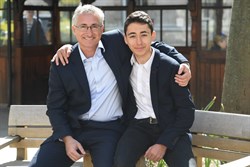Student develops lifesaving heart code

An innovative code developed by a sixth form student with a team of doctors at London’s St Bartholomew’s Hospital could save the lives of heart attack victims by ‘writing’ their medical history inside their chest.
While observing surgery at the hospital’s Barts Heart Centre, one of Europe’s biggest cardiac centres, 16 year old Ben Wald correctly noticed how missing or incomplete medical records may result in extra risk to patients who have had previous heart surgery. There are a number of reasons for this – the patient could have been treated at another hospital, in another country or a number of years ago – making it difficult to quickly retrieve medical records necessary in an emergency.
To solve this problem Ben suggested that the surgeon leave a message in the patient's chest to indicate the number and locations of heart bypass grafts a patient has received. He and his father, Professor David Wald came up with the idea of using the twists and positions of the metal wires used to close the sternum as a code.
Professor David Wald, cardiologist at St Bartholomew’s Hospital and Professor at The Wolfson Institute of Preventive Medicine Queen Mary University of London said: “When operating, cardiologists need to know if the patient has been operated on before and how the previous surgeon has re-plumbed the arteries. When this information is missing, the idea of using sternal wires to let future doctors know what operation was done before is a simple solution that could help many patients.”
About one in six patients who have previously had coronary artery bypass surgery and are taken to hospital suffering a heart attack are at increased risk of complications because the necessary surgical records are not available.
Mr Shipolini, cardiac surgeon at the Barts Heart Centre, said: “This is a fresh and unique idea that solves a common problem many hospitals have. I have used the code and it’s easy to apply using surgical equipment that is already in place. The challenge is now making this code routine and we are talking to surgeons across the country to do so.”
Ben Wald, an A level student from Dulwich College, in southeast London, said: “It was amazing to observe a cardiac surgeon and a cardiologist at work and I am grateful to St Bartholomew’s Hospital for giving me that opportunity.
“It’s strange, but thrilling, to think that a simple question led to this code that could save people’s lives in the future.”
In March 2017, the code was awarded the prestigious Patrick Magee Prize for Innovation from the Society for Cardiothoracic Surgery.
- ENDS -
NOTES TO EDITORS
Photograph: Jeremy Selwyn, Evening Standard
Barts Health NHS Trust
With a turnover of £1.4 billion and a workforce of around 16,000, Barts Health is the largest NHS trust in the country, and one of Britain’s leading healthcare providers. The Trust’s five hospitals – St Bartholomew’s Hospital in the City, including the Barts Heart Centre, The Royal London Hospital in Whitechapel, Newham University Hospital in Plaistow, Whipps Cross University Hospital in Leytonstone and Mile End – deliver high quality compassionate care to the 2.5 million people of East London and beyond.
